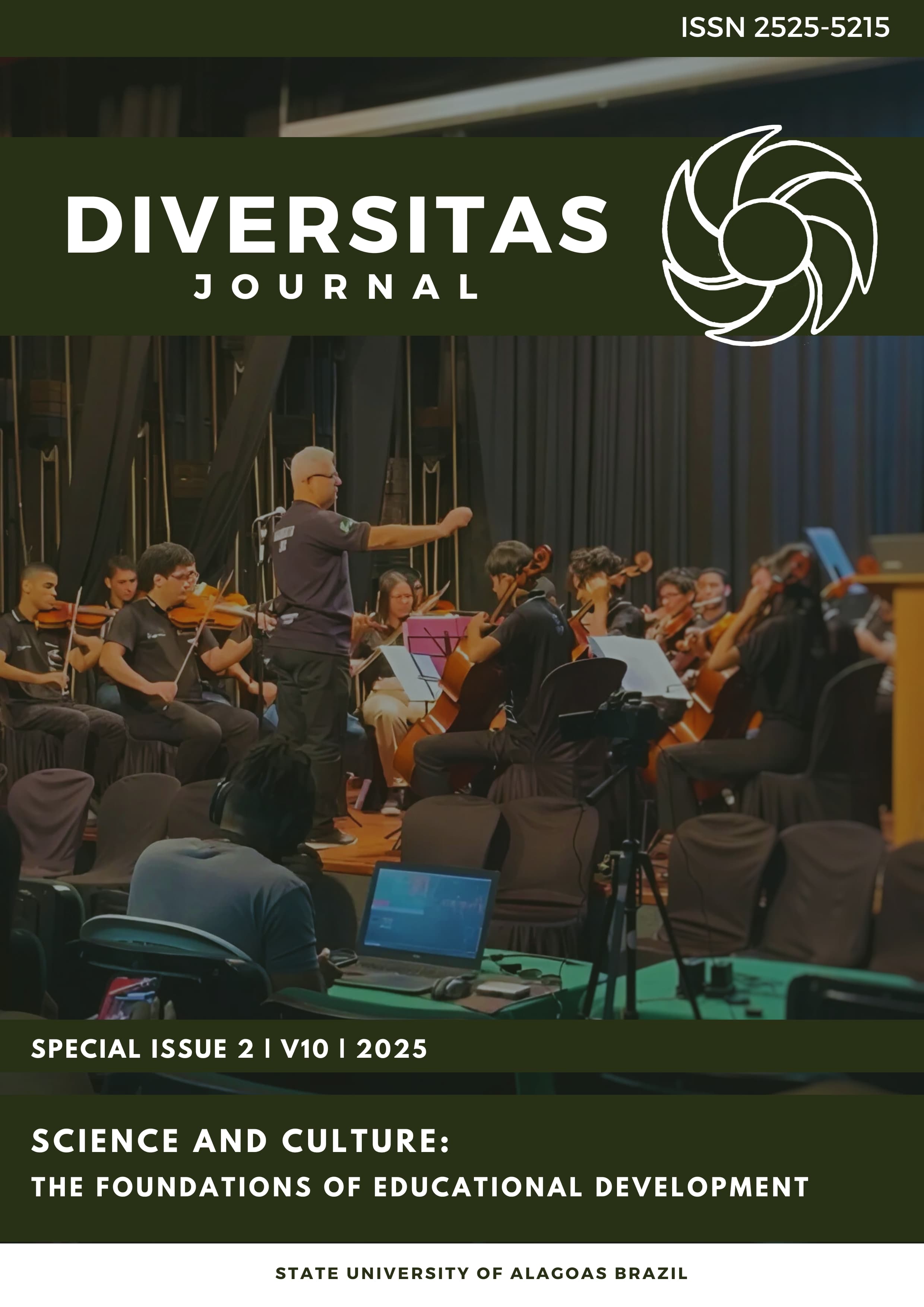The Paulos Honórios of Alagoas: An Analysis of the Hegemonic Masculinity Cabra Macho
An Analysis of the Hegemonic Masculinity Cabra Macho
DOI:
https://doi.org/10.48017/dj.v10iEspecial_2.3271Keywords:
Masculinities, Hegemonic masculinity, cabra machoAbstract
The research investigates hegemonic masculinity based on the story of Paulo Honório from Graciliano Ramos' novel Vidas Secas. This character can be considered a hegemonic man, one who performs a set of heteronormative practices learned through social and cultural experience, enabling the domination of men over other genders. The character embodies a model of masculinity known as cabra macho. This macho configuration describes the behaviors and attitudes that some individuals adopt to assert male superiority. The aim of this research is to analyze the expression of cabra macho masculinity in the state of Alagoas, Brazil. To achieve this goal, the research was grounded in the phenomenological interpretivist paradigm. The subjects of this study were individuals who identify as men, regardless of the sex assigned at birth, living in the state of Alagoas. They were interviewed using a semi-structured guide, and the data was interpreted through content analysis based on a mixed category framework. The results of this research aimed to contribute to gender studies, map models of masculinity in Brazil.
Metrics
References
BUTLER, J. (2019). Atos performáticos e a formação dos gêneros: um ensaio sobre fenome-nologia e teoria feminista. In A. Lorde et al. (Eds.), Pensamento feminista: conceitos fundamentais (pp. 27-50). Bazar do Tempo.
CAMPOS, R. T., & CAMPOS, G. W. de S. (2006). Co-construção de autonomia: o sujeito em questão. Tratado de saúde coletiva, 1, 669-688.
CARRIGAN, T., CONNELL, R. W., & LEE, J. (1985). Towards a new sociology of masculinity. Theory and Society, 14(5), 551-604. https://doi.org/10.1007/BF00160147
CONNELL, R. W., & MESSERSCHMIDT, J. W. (2013). Masculinidade hegemônica: repensan-do o conceito. Revista Estudos Feministas, 21(1), 241-282. https://doi.org/10.1590/S0104-026X2013000100012
DE LOS SANTOS RODRIGUEZ, S. (2019). Um breve ensaio sobre a masculinidade hegemôni-ca. Diversidade e Educação, 7(2), 276-291. https://doi.org/10.1590/2175-042019075011
DE LOS SANTOS RODRÍGUEZ, S., & GOULART, F. O. (2021). O falo nos espaços públicos de Rio Grande, RS, Brasil: falocentrismo e a masculinidade hegemônica. Revista de Ar-queologia, 34(1), 45-70. https://doi.org/10.21625/ra.v34i1.1187
GUERRA, V. M., et al. (2014). Ser homem é...: Adaptação da Escala de Concepções da Masculi-nidade. Psico-Usf, 19, 155-165. https://doi.org/10.1590/1678-7153.201419105
HOOKS, B. (2019). Reconstruindo a masculinidade negra. In Olhares negros: raça e repre-sentação (pp. 89-101). Elefante.
KIMMEL, M. S. (1998). A produção simultânea de masculinidades hegemônicas e subalternas. Horizontes antropológicos, 4(9), 103-117. https://doi.org/10.1590/S1982-17582018000100007
LERNER, G. (2019). A criação do patriarcado. BOD GmbH DE.
NATT, E. D. M., & DE PÁDUA CARRIERI, A. (2016). É para menino ou para menina? Repre-sentações de masculinidade e feminilidade. Revista Latino-Americana de Geografia e Gênero, 7(1), 109-131. https://doi.org/10.5935/2176-9039.20160007
OLIVEIRA, P. P. (2004). A construção social da masculinidade. Editora UFMG.
PETRY, A. R., & MEYER, D. E. (2011). Transexualidade e heteronormatividade: algumas ques-tões para a pesquisa. Textos & Contextos (Porto Alegre), 10(1), 193-198. https://doi.org/10.15448/1980-3358.2011.1.10399
RAMOS, G. (1990). São Bernardo (52nd ed.). Record.
RIBEIRO, A. A. M., & FAUSTINO, D. M. (2017). Negro tema, negro vida, negro drama: estudos sobre masculinidades negras na diáspora. Revista Transversos, 10, 163-182. https://doi.org/10.22290/rt.v10i0.7023
ROESCH, S. M. A. (2007). Projetos de estágio e pesquisa em administração: guia para está-gios, trabalhos de conclusão, dissertações e estudos de caso. Atlas.
SANTOS, H., FERREIRA, M., & SILVA, S. M. (2013). "Gay mas não bicha": de uma heteromas-culinidade hegemónica a uma proliferação de masculinidades gays. Revista de Estudos de Gênero, 13(2), 45-68. https://doi.org/10.1590/2179-914X.2013.0028
SARAIVA, L. A. S., SANTOS, L. T. dos, & PEREIRA, J. R. (2020). Heteronormatividade, mas-culinidade e preconceito em aplicativos de celular: o caso do Grindr em uma cidade bra-sileira. BBR. Brazilian Business Review, 17, 114-131. https://doi.org/10.15728/bbr.2020.17.1.5
VILLAPLANA, Á. C. (2014). Gente queer: masculinidades femeninas y el dilema de las identi-dades. Cuadernos Intercambio sobre Centroamérica y el Caribe, 11(2), 117-143. https://doi.org/10.22282/cicac.v11i2.203
Downloads
Published
How to Cite
Issue
Section
License
Copyright (c) 2025 Ericlis Roberto Aguiar dos Santos

This work is licensed under a Creative Commons Attribution 4.0 International License.
The Diversitas Journal expresses that the articles are the sole responsibility of the Authors, who are familiar with Brazilian and international legislation.
Articles are peer-reviewed and care should be taken to warn of the possible incidence of plagiarism. However, plagiarism is an indisputable action by the authors.
The violation of copyright is a crime, provided for in article 184 of the Brazilian Penal Code: “Art. 184 Violating copyright and related rights: Penalty - detention, from 3 (three) months to 1 (one) year, or fine. § 1 If the violation consists of total or partial reproduction, for the purpose of direct or indirect profit, by any means or process, of intellectual work, interpretation, performance or phonogram, without the express authorization of the author, the performer, the producer , as the case may be, or whoever represents them: Penalty - imprisonment, from 2 (two) to 4 (four) years, and a fine. ”


















